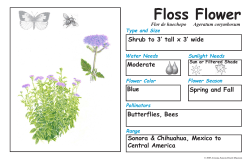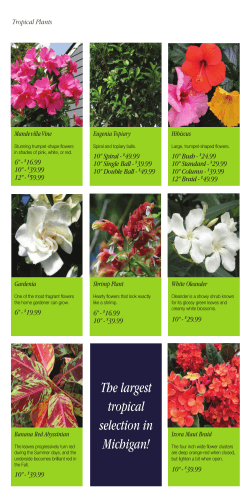
Pollinator Factsheet - Amazon Web Services
Pollinator Factsheet Pollinators are critical to our environment. An estimated 200,000 different species of animals around the globe provide pollination services, such as generating food and cover for wildlife, preventing erosion, and keeping waterways clean, all of which are necessary for healthy ecosystems and agriculture. Roughly 1,000 pollinators are vertebrates, including birds, bats and small mammals. The remaining pollinators are invertebrates such as butterflies, moths, flies and bees. Although some plant species need wind or water to transfer pollen from one flower to another, 91 percent of flowering plants require insect or animal pollination to jump-start seed and fruit production and reproduction. Not only do pollinators provide vital ecosystem services, they are critical to 75 percent of crop varieties grown worldwide and contribute $40 billion to the U.S. economy annually. Unfortunately, the health and productivity of these pollinators is in jeopardy. At least 185 pollinators are listed as threatened or extinct by the World Conservation Union (IUCN), and at least 15 are listed as endangered in the United States. Here’s a snapshot of some pollinators you might encounter in your backyard: Bees Bees are essential pollinators for terrestrial ecosystems, food crops, and garden, meadow and forest plants. Bees are responsible for one in three bites of food we eat, but populations are in great peril and dwindling worldwide. In the U.S. there are more than 4,000 species of bees, many of which are solitary bees. Worldwide, there are 20,000 species. The majority of bees visit flowers for pollen and/or nectar, which are important food sources. Bees can see colors in the ultraviolet range and as a result, they are attracted to flowers that are blue, purple and yellow. They travel to these flowers at 7 miles per hour and beat their wings at 190 times per second. : learn more and take action. Butterflies There are more than 700 species of butterflies in North America. Butterflies are attracted to bright flowers that are red, pink, yellow, orange, or blue, have a sweet smell, and are flat and easy to walk on, but some tubular flowers also attract butterflies. The insects typically gather on patches of mud or along puddles to drink. A butterfly has four life stages: egg, caterpillar, pupa and adult. At each stage, the butterfly needs different elements in its habitat. Butterfly eggs need leaves, tree branches, shrubs or wildflowers to rest. As caterpillars, they need to eat the leaves, stems, flowers and fruits of specific host plants to survive. As pupae, they need protected locations where they won’t be disturbed, such as a pile of leaves, tall grass or bushes. And as butterflies, they needs nectar from flowers and a warm climate. Some butterflies are in peril. For example, monarch population numbers have fallen by 90% in less than 20 years. Bats There are 45 species of bats in the U.S. and 40 percent are either endangered or suffering decline. Some plants with nocturnal blossoms rely on bats for pollination. Crops that require bats for pollination include bananas, mangoes, figs, avocadoes, guava, agaves and peaches. Most bats are generalist feeders, but some are frugivorous and nectivorous and eat fruit, pollen, or nectar from plants or flowers. Bats need open bodies of clean water to drink from and habitat over streams or other bodies of water, woodlot canopies or fields and agricultural land. Moths Most moths are active at twilight or during the night and are critical pollinators for night-blooming flowers. They typically have robust bodies with feathery antennae and provide pollination to desert regions of the southwestern United States. Pollinator Factsheet Hummingbirds Hummingbirds are highly efficient pollinators and pollinate a number of shrubs, vines and flowers, but surveys indicate declining numbers in recent decades. They feed during the daytime and while hovering. Their long beaks and tongues are ideal for pollinating long, tubular blossoms. Hummingbirds do not have a sense of smell, but are primarily attracted to vibrant colored flowers, especially pink, orange and red flowers, but will feed on any flower with nectar. They typically occupy woodland areas, forests, gardens, scrub communities, and orchards and construct their nests from plant fibers and bind themwith spider silk. During the winter, hummingbirds migrate to tropical climates. Wasps Wasps can easily be confused with bees because their coloring can be similar. However, they are less efficient pollinators than bees. Wasps typically have smooth, shiny bodies with narrow abdomens, simple unbranched hairs and some are yellow with black coloring. Fig wasps are particularly important pollinators-without them, we wouldn’t have figs. Ants Ants typically visit flowers to collect nectar, but do not cross-pollinate flowers. Since they are wingless, they must crawl into each flower for the nectar. They like to visit low-growing flowers that are inconspicuous and are located close to the stem of the flower. Some tropical plants have nectar outside of the flowers to attract the ants and rely on their defensive skills to protect the plant from being attacked by other insects. Flies There are hundreds of thousands of species of flies. They are generalist pollinators and usually visit flowers that are open and shallow, have easy access to pollen and nectar and are pale and dull to dark brown or purple in color. Flies are typically attracted to flowers that are flecked with translucent patches, have a strong odor and are funnel-like or have complex traps. Flies can be confused with bees, but flies have one pair of wings, while bees have four. They need food, water and shelter in sufficient quality and quantity for all of their life stages, which include egg, larva, pupa and adult. Mosquitoes Mosquitoes are more than just a nuisance, they’re pollinators! There are more than 3,000 species of mosquitoes. Males feed exclusively on plant nectar and help facilitate pollen transmission. Mosquitoes such as the genus Aedus are orchid pollinators in North America. Beetles There are more than 30,000 species of beetles in the U.S. and 300,000 species in the world. Some pollinating beetles are very small and look like small black dots on flowers, while others are large and colorful, but they are characterized by their hard wing coverings. Beetles feed on pollen and nectar and are sometimes referred to as “mess and soil” pollinators because they will defecate on flowers or damage parts of flowers after feeding on them. Fun fact: Lizards, lemurs, rodents, midges and possums are all pollinators too! : learn more and take action.
© Copyright 2025













